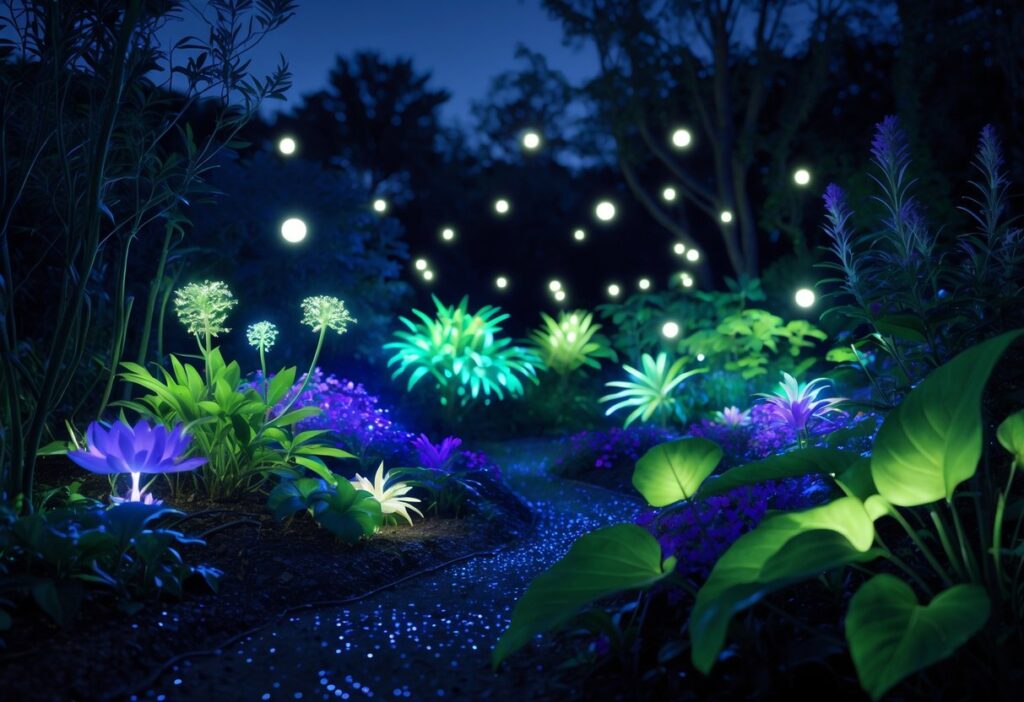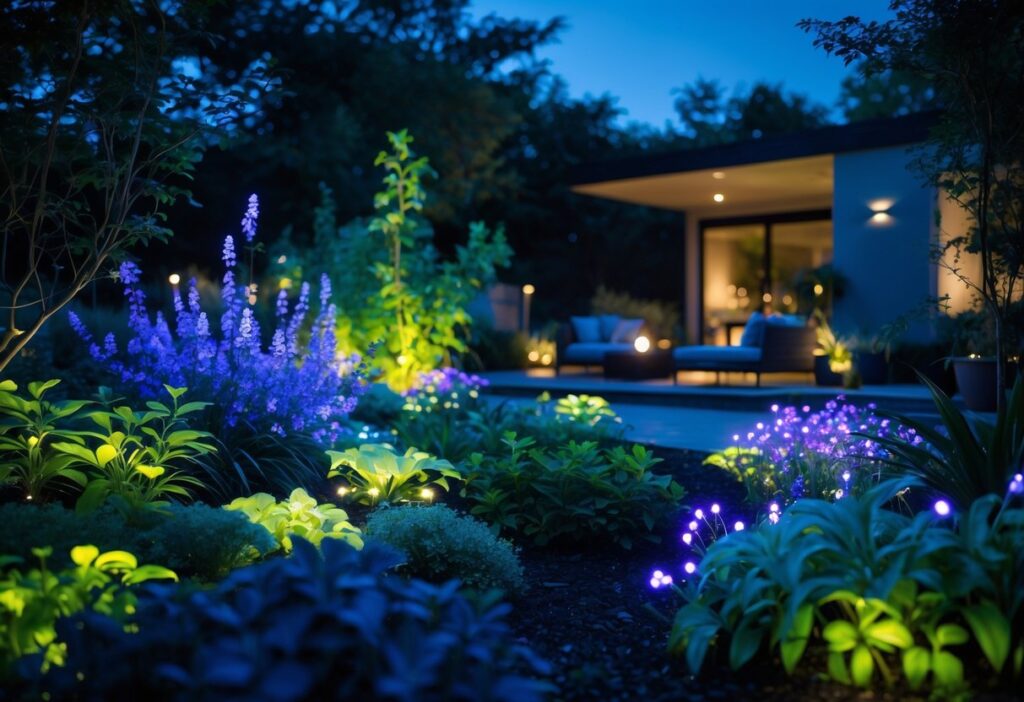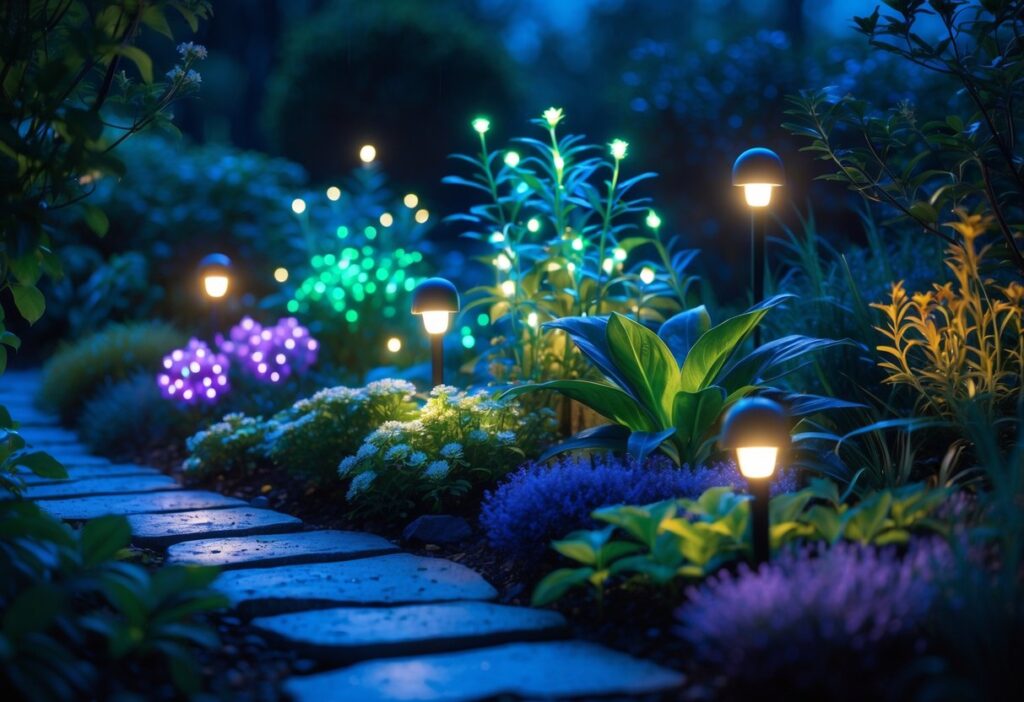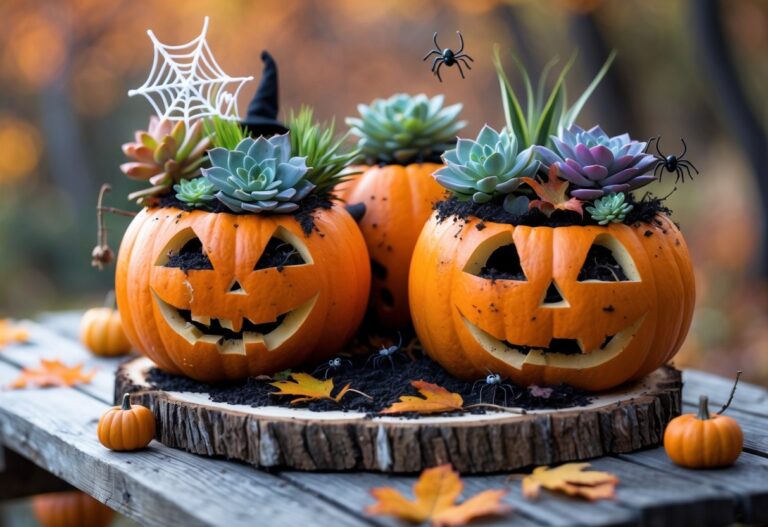Night gardens are catching on, probably because they offer a fresh way to enjoy your yard after dark. There’s just something about plants that bloom or glow at night—it’s like having your own secret world outside.
These glowing or night-blooming plants soak up sunlight all day and then come alive after sunset, adding unexpected beauty and a gentle glow when you’d usually expect nothing but darkness.

You don’t need fancy lights or high-tech gadgets to enjoy these gardens. Just the right mix of plants can turn your space into a calm, almost magical retreat that smells amazing and looks surreal under the moon.
Night gardens attract nighttime pollinators too, which means you’re helping nature do its thing around the clock.
Why Night Gardens Are Growing in Popularity
More folks are choosing night gardens because they bring something different to the table—unique visuals and a chance to support nocturnal wildlife. There’s also something to be said for the peace you get sitting outside after sunset, away from the daytime rush.
Honestly, being out there in the cool evening air, surrounded by plants that come alive at night, feels good for the soul. It’s a little escape that also helps pollinators do their nighttime work.
The Allure of Plants That Shine at Night
Night gardens usually feature plants with bright, reflective petals that almost glow in the moonlight. Some people call these “moon garden flowers.” They really do set a peaceful, magical vibe—almost like you’ve stepped into a dream.
It’s not just about looks, though. Those pale flowers help attract pollinators like moths and bats, who are busy after dark. If you focus on silver, white, or light-colored blooms and foliage, your garden pops at night without any harsh lighting.
And, honestly, the scents are something else. Some night-bloomers release rich fragrances in the evening, which adds another layer to the whole experience.
Night Gardens as Ecological Havens

Night gardens support creatures you don’t usually see in the daytime. Flowers that open or become fragrant after dark provide food for night pollinators—think moths, beetles, bats. These little guys are crucial for keeping ecosystems running smoothly.
If you pick native or cottage-garden plants, you’re giving a bigger boost to local insects than you would with heavily bred ornamentals. Even letting your grass or wildflowers bloom can make a difference, creating tiny habitats for nighttime critters.
Your night garden, even if it’s small, becomes a safe spot for wildlife that often gets overlooked.
Therapeutic and Social Benefits of Night Gardening
There’s something soothing about gardening at night. The air is cooler, the world’s quieter, and you can just breathe. It’s a welcome break from daytime chaos.
Plus, night gardens open up new ways to spend time with friends and family. Imagine hosting a little evening get-together surrounded by glowing plants and gentle scents—way more interesting than just sitting indoors, right?
Essential Plants and Lighting for a Luminous Night Garden

Building a night garden is all about picking plants that show off after dark and adding lighting that makes them shine. The right choices fill your space with soft color and scent, while a few well-placed lights keep things inviting—and safe—after sunset.
Top Night-Blooming and Glowing Plants
Go for plants that open up or smell stronger in the evening. Moonflower has big, white blooms that almost glow in the dark. Night-blooming jasmine is famous for its sweet, powerful scent, and it attracts moths and bats.
Tuberose and evening primrose are also great picks for nighttime fragrance and pale flowers. If you want something rare, Queen of the Night cactus only blooms at night—talk about special.
Honeysuckle brings a rich aroma and lures in night pollinators, while white roses add a touch of elegance and stay visible even when it’s dark.
Designing With White and Reflective Foliage
Choosing white or silvery plants really makes a difference for nighttime visibility. Soft colors bounce moonlight and any garden lights you use, making the whole space feel brighter without being overwhelming.
Plants like dusty miller and lamb’s ear have silvery-gray leaves that catch the light and add texture. Try putting these near walkways or seating areas—they help highlight the shapes and layers of your garden in a subtle way.
Night gardens aren’t just about plants—they’re about creating a vibe that’s peaceful, a little mysterious, and honestly, just plain lovely. If you’ve never tried sitting outside surrounded by glowing blooms and sweet scents, maybe it’s time to give it a shot. After all, why let the magic stop when the sun goes down?
Lighting Techniques for Magical Nighttime Effects
Pick lighting that sets a mood but also keeps things safe—nobody wants to trip in the dark. I tend to go for solar-powered lights or lanterns since they’re easy on the planet and, honestly, look pretty charming.
String some fairy lights around trees or shrubs if you want that bit of sparkle. It’s amazing how a few twinkling lights can change the whole vibe.
Try downlighting above your plants to mimic moonlight. It’s a neat trick for making flowers pop, almost like they’re on stage for a night show.
Timers or motion sensors? They’re a lifesaver if you’re forgetful (like me) and want to save a little energy. Your garden still glows when you actually want to see it.
Keep the light levels soft; blasting your yard with brightness just ruins the magic. Place lights near night-bloomers or anything with reflective leaves—those spots really come alive after sunset.
In the end, it’s about finding that sweet spot between beauty and function. With a little experimenting, your nighttime garden can feel downright enchanting.



